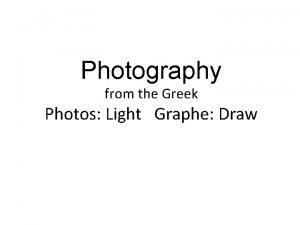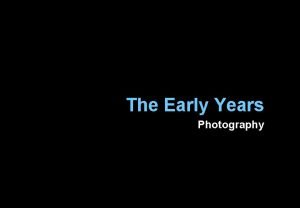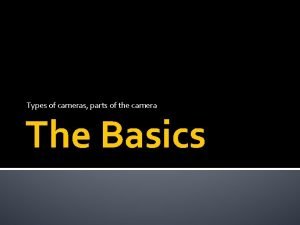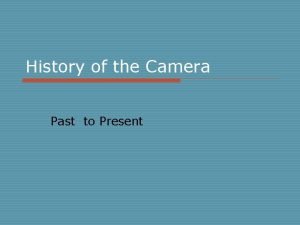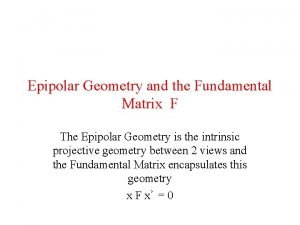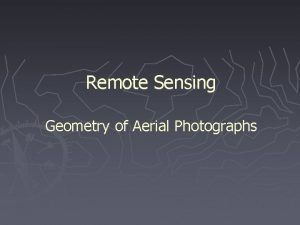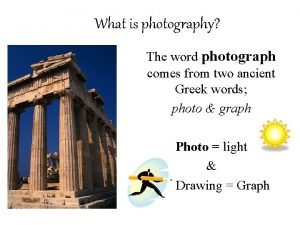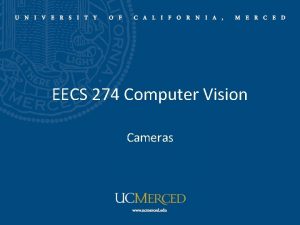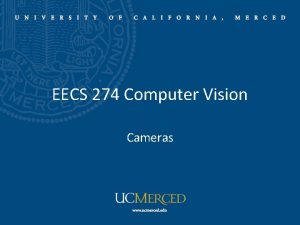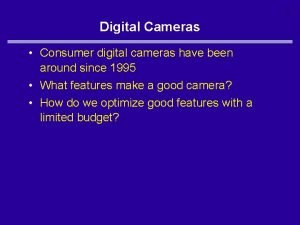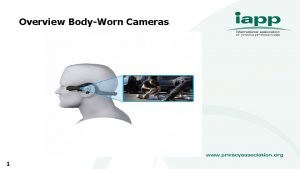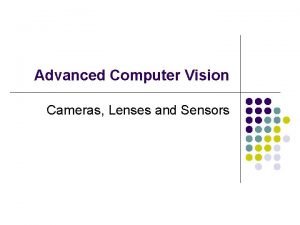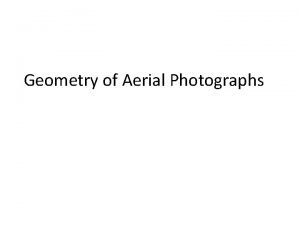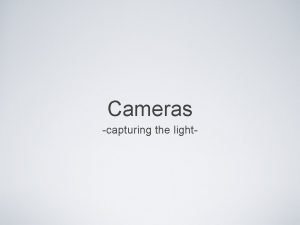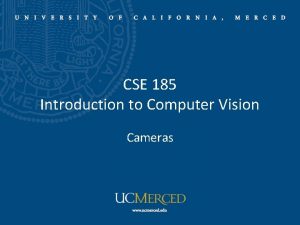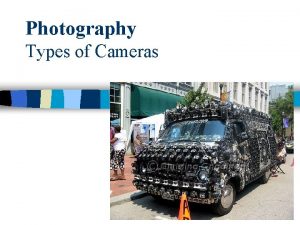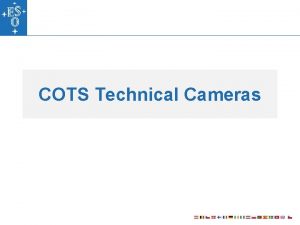Cameras First photograph due to Niepce First on


























- Slides: 26

Cameras • First photograph due to Niepce • First on record shown 1822 • Basic abstraction is the pinhole camera – lenses required to ensure image is not too dark – various other abstractions can be applied Computer Vision - A Modern Approach Set: Cameras Slides by D. A. Forsyth

Pinhole cameras • Abstract camera model box with a small hole in it • Pinhole cameras work in practice Computer Vision - A Modern Approach Set: Cameras Slides by D. A. Forsyth

Distant objects are smaller Computer Vision - A Modern Approach Set: Cameras Slides by D. A. Forsyth

Parallel lines meet Common to draw film plane in front of the focal point. Moving the film plane merely scales the image. Computer Vision - A Modern Approach Set: Cameras Slides by D. A. Forsyth

Vanishing points • each set of parallel lines (=direction) meets at a different point – The vanishing point for this direction • Sets of parallel lines on the same plane lead to collinear vanishing points. • Good ways to spot faked images – scale and perspective don’t work – vanishing points behave badly – supermarket tabloids are a great source. – The line is called the horizon for that plane Computer Vision - A Modern Approach Set: Cameras Slides by D. A. Forsyth

Computer Vision - A Modern Approach Set: Cameras Slides by D. A. Forsyth

The equation of projection Computer Vision - A Modern Approach Set: Cameras Slides by D. A. Forsyth

The equation of projection • Cartesian coordinates: – We have, by similar triangles, that (x, y, z) -> (f x/z, f y/z, -f) – Ignore third coordinate, and get Computer Vision - A Modern Approach Set: Cameras Slides by D. A. Forsyth

Homogenous coordinates • Add an extra coordinate and use an equivalence relation • for 2 D – equivalence relation k*(X, Y, Z) is the same as (X, Y, Z) • for 3 D – equivalence relation k*(X, Y, Z, T) is the same as (X, Y, Z, T) • Basic notion – Possible to represent points “at infinity” • Where parallel lines intersect • Where parallel planes intersect – Possible to write the action of a perspective camera as a matrix Computer Vision - A Modern Approach Set: Cameras Slides by D. A. Forsyth

The camera matrix • Turn previous expression into HC’s – HC’s for 3 D point are (X, Y, Z, T) – HC’s for point in image are (U, V, W) Computer Vision - A Modern Approach Set: Cameras Slides by D. A. Forsyth

Weak perspective • Issue – perspective effects, but not over the scale of individual objects – collect points into a group at about the same depth, then divide each point by the depth of its group – Adv: easy – Disadv: wrong Computer Vision - A Modern Approach Set: Cameras Slides by D. A. Forsyth

Orthographic projection Computer Vision - A Modern Approach Set: Cameras Slides by D. A. Forsyth

The projection matrix for orthographic projection Computer Vision - A Modern Approach Set: Cameras Slides by D. A. Forsyth

Pinhole too big many directions are averaged, blurring the image Pinhole too smalldiffraction effects blur the image Generally, pinhole cameras are dark, because a very small set of rays from a particular point hits the screen. Computer Vision - A Modern Approach Set: Cameras Slides by D. A. Forsyth

The reason for lenses Computer Vision - A Modern Approach Set: Cameras Slides by D. A. Forsyth

The thin lens Computer Vision - A Modern Approach Set: Cameras Slides by D. A. Forsyth

Spherical aberration Computer Vision - A Modern Approach Set: Cameras Slides by D. A. Forsyth

Lens systems Computer Vision - A Modern Approach Set: Cameras Slides by D. A. Forsyth

Vignetting Computer Vision - A Modern Approach Set: Cameras Slides by D. A. Forsyth

Other (possibly annoying) phenomena • Chromatic aberration – Light at different wavelengths follows different paths; hence, some wavelengths are defocussed – Machines: coat the lens – Humans: live with it • Scattering at the lens surface – Some light entering the lens system is reflected off each surface it encounters (Fresnel’s law gives details) – Machines: coat the lens, interior – Humans: live with it (various scattering phenomena are visible in the human eye) • Geometric phenomena (Barrel distortion, etc. ) Computer Vision - A Modern Approach Set: Cameras Slides by D. A. Forsyth

Camera parameters • Issue – camera may not be at the origin, looking down the z-axis • extrinsic parameters – one unit in camera coordinates may not be the same as one unit in world coordinates • intrinsic parameters - focal length, principal point, aspect ratio, angle between axes, etc. Computer Vision - A Modern Approach Set: Cameras Slides by D. A. Forsyth

Camera calibration • Issues: • Error minimization: – what are intrinsic parameters of the camera? – what is the camera matrix? (intrinsic+extrinsic) – Linear least squares • easy problem numerically • solution can be rather bad – Minimize image distance • General strategy: – view calibration object – identify image points – obtain camera matrix by minimizing error – obtain intrinsic parameters from camera matrix • more difficult numerical problem • solution usually rather good, • start with linear least squares – Numerical scaling is an issue Computer Vision - A Modern Approach Set: Cameras Slides by D. A. Forsyth

Geometric properties of projection • • Points go to points Lines go to lines Planes go to whole image Polygons go to polygons • Degenerate cases – line through focal point to point – plane through focal point to line Computer Vision - A Modern Approach Set: Cameras Slides by D. A. Forsyth

Polyhedra project to polygons • (because lines project to lines) Computer Vision - A Modern Approach Set: Cameras Slides by D. A. Forsyth

Junctions are constrained • This leads to a process called “line labelling” – one looks for consistent sets of labels, bounding polyhedra – disadv - can’t get the lines and junctions to label from real images Computer Vision - A Modern Approach Set: Cameras Slides by D. A. Forsyth

Curved surfaces are much more interesting • Crucial issue: outline is the set of points where the viewing direction is tangent to the surface • This is a projection of a space curve, which varies from view to view of the surface Computer Vision - A Modern Approach Set: Cameras Slides by D. A. Forsyth
 Pinhole camera effect
Pinhole camera effect Niepce first photograph
Niepce first photograph Joseph niepce first photo
Joseph niepce first photo Joseph nicéphore niépce
Joseph nicéphore niépce Joseph nicéphore niépce
Joseph nicéphore niépce Joseph nicéphore niépce biography
Joseph nicéphore niépce biography Joseph nicephore niepce
Joseph nicephore niepce First photograph of a person
First photograph of a person Film photography history
Film photography history Photography composition exercises
Photography composition exercises To the little polish boy standing with his arms up
To the little polish boy standing with his arms up Who took the first photograph
Who took the first photograph Speed detection of moving vehicle
Speed detection of moving vehicle Gamma cameras bbc bitesize
Gamma cameras bbc bitesize Stem-and-leaf
Stem-and-leaf Cameras parts
Cameras parts Image formation in camera
Image formation in camera Present camera
Present camera Essential matrix
Essential matrix Principio di conservazione della quantità di moto
Principio di conservazione della quantità di moto Ha quattro angoli e quattro lati
Ha quattro angoli e quattro lati Substantive vs procedural due process
Substantive vs procedural due process Slidetodoc. com
Slidetodoc. com Tomie photograph
Tomie photograph Adverb of photograph
Adverb of photograph Geometry of vertical photograph
Geometry of vertical photograph Where did the word photography come from
Where did the word photography come from




